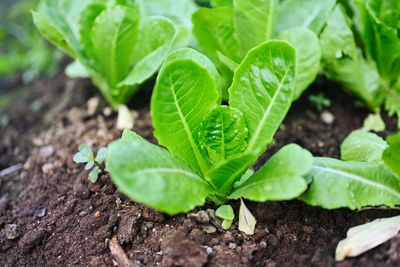Lettuce

Introduction
- Lettuce is one of the most rewarding cool-season crops for our climate. This versatile green thrives in our mild fall, winter, and spring weather. With so many varieties and colors, lettuce can be both a productive food crop and an attractive addition to your garden beds and containers.
Quick Facts
- Type: Cool-season annual
- Height: 6–12 inches, depending on type
- Harvest Season: Fall, winter, and early spring
- Sun Requirements: Full sun in cool months; partial afternoon shade in spring to delay bolting
- Soil Type: Loose, fertile soil rich in compost
- Water Needs: Regular and consistent moisture; shallow roots dry out quickly
Planting Guide
When to Plant
- Direct seed or transplant:
- Fall crop: September–October
- Winter crop: November–January (in frost-free microclimates or under row cover)
- Spring crop: February–April
- Avoid summer planting—high heat quickly causes bolting and bitter flavor.
Where to Plant
- Choose a sunny spot for fall/winter crops.
- For spring crops, provide afternoon shade or use shade cloth to help plants last longer before bolting.
- Great for containers and raised beds—ideal for small spaces and easy harvesting.
How to Plant
- Seeds: Sow ⅛ inch deep, spacing 1 inch apart. Thin to 6–8 inches apart for leaf lettuce, 10–12 inches for romaine and butterhead.
- Transplants: Space according to variety. Handle gently—lettuce roots are shallow and delicate.
- Soil prep: Enrich soil with compost before planting; lettuce is a heavy feeder.
- Watering: Keep soil consistently moist, especially during germination (7–10 days).
Care & Maintenance
- Watering: Provide frequent, light watering; dry soil leads to bitterness and bolting.
- Fertilizing: Apply a balanced, nitrogen-rich organic fertilizer every 3–4 weeks. Side-dressing with compost also works well.
- Bolting: As temperatures rise in late spring, lettuce will form flower stalks. Plant bolt-resistant varieties and use shade cloth to extend harvests.
- Pests & diseases: Watch for aphids, snails, and slugs. Control pests with row covers, handpicking, or organic sprays as needed.
Harvesting
- Leaf types: Harvest outer leaves as soon as they reach 3–4 inches, or cut the entire plant at the base.
- Head types: Harvest when heads are firm and full-sized.
- For a continuous harvest, plant small patches every 2–3 weeks during the growing season.
Lifecycle & Reseeding
- Lettuce is an annual and does not regrow once harvested.
- If left to bolt, plants will produce seeds, which can be saved or allowed to self-sow in cooler months.
Wildlife & Companion Benefits
- Flowers attract pollinators if plants are left to bloom.
- Grows well with carrots, radishes, beets, and onions.
- Avoid planting near brassicas, which compete for similar nutrients.
Extra Tips
- For winter crops, choose frost-tolerant varieties like romaine and leaf lettuces.
- In spring, plant heat-tolerant varieties for longer harvests.
- Protect young seedlings from slugs and snails by using copper tape around containers or organic slug bait.
- Extend your lettuce harvest by growing in containers you can move to cooler spots as temperatures rise.
Where to Get Seeds
- Click here .